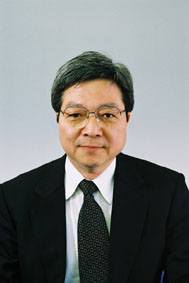Last Update 08/29 2003
Research: Main research interest of my group is understanding the genesis of magmas and the behavior of aqueous fluid at high pressure. Through the petrological and geochemical study of the Deccan flood basalt, pristine basalts, which show least evidence of crustal contamination, have been discriminated. It has been demonstrated that the chemical signature of the pristine basalt cannot be derived from the partial melt of mantle peridotite. Combining the results of melting experiments of a MORB and peridotites at pressure of 3-5 GPa, it has been concluded that the Deccan pristine magma could be obtained by the mixing of two magmas, one formed by extensive melting of the basalt fragments included in the ascending peridotite plume, and the other formed by small degree of melting of the ambient peridotite. The basalt fragments should be the subducted ancient oceanic crust accumulated at the base of the upper mantle. Based on the high pressure experiments, we found that the aqueous fluid coexisting with mantle minerals, olivine and pyroxene, can dissolve more than 70 wt % of silicate components at 8 GPa. This result indicates that once we have water inside of the earth, we can expect the existence of fluid enriched in silicate without melting. Because the solubility of silicate in the aqueous fluid decreases with decreasing pressure, migration of silicate-enriched aqueous fluid toward the earth\'s surface may cause differentiation en route. Also the wetting of olivine against the aqueous fluid has been determined to understand the mobility of aqueous fluid at pressure, 3-8 GPa, and it has been shown that the wetting is incomplete at pressure below 3 GPa in hydrous upper mantle peridotite at convergent plate boundaries. We are now proposing that the wetting of olivine above 3 GPa may control the location of volcanic front at subduction zone. Another recent target is Fuji volcano. We are focusing on the magmatic evolution of Fuji volcano. Publications: Yasuda, A., T. Fujii and K. Kurita, Melting phase relations of an anhydrous mid-ocean ridge basalt from 3 to 20 Gpa: Impliations for the behavior of subducted ocean crust in the mantle, J. Geophys. Res., 99, 9401--9414, 1994. Fujii, T. and S. Nakada, The 15-September 1991pyroclastic flows at Unzen Volcano (Japan): a flowing model., Journal of Volcanology and Geothermal Research, 89, 1/4, 159--172, 1999. Sano, T., Fujii, T., Deshmukh, S.S., Fukuoka, T., & Aramaki, S., Differentiation processes of Deccan Trap basalts: Contribution from geochemistry and experimental petrology, Jour. Petrology, 42, 12, 2175--2195, 2001. Mibe, K., Fujii, T., and Yasuda, A., Composition of aqueous fluid coexisting with mantle minerals at high pressure and its bearing on the differentiation of the Earth's mantle, Geochim. Cosmoshim. Acta, 66, 12, 2273--2285, 2002. 藤井敏嗣, 火山のもとーマグマのできかたー(山下輝夫編,大地の躍動をみる), 岩波書店, 2000. 藤井敏嗣, 地殻のつくり方(川勝 均編,地球のダイナミクスとトモグラフィー), 朝倉書店, 2002. |
